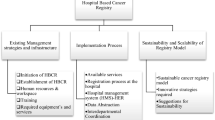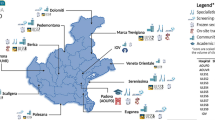Abstract
Key quality parameters in diagnostic pathology include timeliness, accuracy, completeness, conformance with current agreed standards, consistency and clarity in communication. In this review, we argue that with worldwide developments in eHealth and big data, generally, there are two further, often overlooked, parameters if our reports are to be fit for purpose. Firstly, population-level studies have clearly demonstrated the value of providing timely structured reporting data in standardised electronic format as part of system-wide quality improvement programmes. Moreover, when combined with multiple health data sources through eHealth and data linkage, structured pathology reports become central to population-level quality monitoring, benchmarking, interventions and benefit analyses in public health management. Secondly, population-level studies, particularly for benchmarking, require a single agreed international and evidence-based standard to ensure interoperability and comparability. This has been taken for granted in tumour classification and staging for many years, yet international standardisation of cancer datasets is only now underway through the International Collaboration on Cancer Reporting (ICCR). In this review, we present evidence supporting the role of structured pathology reporting in quality improvement for both clinical care and population-level health management. Although this review of available evidence largely relates to structured reporting of cancer, it is clear that the same principles can be applied throughout anatomical pathology generally, as they are elsewhere in the health system.



Similar content being viewed by others
References
RCPA (Royal College of Pathologists of Australasia) (2009) Structured pathology reporting of cancer. http://www.rcpa.edu.au/Publications/StructuredReporting.htm. Accessed 4 June 2015
RCPath (Royal College of Pathologists) datasets and tissue pathways. http://www.rcpath.org/index.asp?PageID=254. Accessed 4 June 2015
Cancer Committee C (2009) Cancer protocols and checklists. Cancer checklists. http://www.cap.org/apps/cap.portal?_nfpb=true&cntvwrPtlt_actionOverride=%2Fportlets%2FcontentViewer%2Fshow&_windowLabel=cntvwrPtlt&cntvwrPtlt%7BactionForm.contentReference%7D=committees%2Fcancer%2Fcancer_protocols%2Fprotocols_index.html&_state=maximized&_pageLabel=cntvwr Accessed 4 June 2015
Casati B, Bjugn R (2012) Structured electronic template for histopathology reporting on colorectal carcinoma resections: five-year follow-up shows sustainable long-term quality improvement. Arch Pathol Lab Med 136:652–656
Daniel C, Shrader T (2010) White paper: anatomic pathology structured reports. http://wiki.ihe.net/index.php?title=Anatomic_Pathology_Structured_Reports. Accessed 4 June 2014 2015
Daniel C, Macary F, Rojo MG, Klossa J et al (2011) Recent advances in standards for collaborative digital anatomic pathology. Diagn Pathol 6(Suppl 1):S17
DICOM Standards Committee WG, Pathology (2010) Digital imaging and communications in medicine, supplement 145: whole slide image IOD and SOP classes. ftp://medical.nema.org/medical/dicom/final/sup145_ft.pdf. Accessed 4 June 2015
Temple WJ, Chin-Lenn L, Mack LA, Cancer Surgery A (2014) Evaluating population-based breast cancer surgical practice in real time with a web-based synoptic operative reporting system. Am J Surg 207:693–696, discussion 696–697
Edhemovic I, Temple WJ, de Gara CJ, Stuart GC (2004) The computer synoptic operative report—a leap forward in the science of surgery. Ann Surg Oncol 11:941–947
Hoffer DN, Finelli A, Chow R, Liu J et al (2012) Structured electronic operative reporting: comparison with dictation in kidney cancer surgery. Int J Med Inform 81:182–191
Aabakken L, Barkun AN, Cotton PB, Fedorov E et al (2014) Standardized endoscopic reporting. J Gastroenterol Hepatol 29:234–240
Kumarasinghe MP, Brown I, Raftopoulos S, Bourke MJ et al (2014) Standardised reporting protocol for endoscopic resection for Barrett oesophagus associated neoplasia: expert consensus recommendations. Pathology 46:473–480
Soekhoe JK, Groenen MJ, van Ginneken AM, Khaliq G et al (2007) Computerized endoscopic reporting is no more time-consuming than reporting with conventional methods. Eur J Intern Med 18:321–325
Powell DK, Silberzweig JE (2015) State of structured reporting in radiology, a survey. Acad Radiol 22:226–233
Larson DB, Towbin AJ, Pryor RM, Donnelly LF (2013) Improving consistency in radiology reporting through the use of department-wide standardized structured reporting. Radiology 267:240–250
Brook OR, Brook A, Vollmer CM, Kent TS et al (2015) Structured reporting of multiphasic CT for pancreatic cancer: potential effect on staging and surgical planning. Radiology 274:464–472
von Wangenheim A, Barcellos CL Jr, Andrade R, de Carlos Back Giuliano I et al (2013) Implementing DICOM structured reporting in a large-scale telemedicine network. Telemed J E Health 19:535–541
Nayar R, Wilbur DC (2015) The Pap Test and Bethesda 2014. “The reports of my demise have been greatly exaggerated.” (after a quotation from Mark Twain). Acta Cytol 59:121–132
Ali SZ (2011) Thyroid cytopathology: Bethesda and beyond. Acta Cytol 55:4–12
Srigley JR, McGowan T, Maclean A, Raby M et al (2009) Standardized synoptic cancer pathology reporting: a population-based approach. J Surg Oncol 99:517–524
Merlin T, Weston A, Tooher R (2009) Extending an evidence hierarchy to include topics other than treatment: revising the Australian ‘levels of evidence’. BMC Med Res Methodol 9:34
Simpson RW, Berman MA, Foulis PR, Divaris DX et al (2015) Cancer biomarkers: the role of structured data reporting. Arch Pathol Lab Med 139:587–593
Scolyer RA, Judge MJ, Evans A, Frishberg DP et al (2013) Data set for pathology reporting of cutaneous invasive melanoma: recommendations from the International Collaboration on Cancer Reporting (ICCR). Am J Surg Pathol 37:1797–1814
McCluggage WG, Colgan T, Duggan M, Hacker NF et al (2013) Data set for reporting of endometrial carcinomas: recommendations from the International Collaboration on Cancer Reporting (ICCR) between United Kingdom, United States, Canada, and Australasia. Int J Gynecol Pathol 32:45–65
Jones KD, Churg A, Henderson DW, Hwang DM et al (2013) Data set for reporting of lung carcinomas: recommendations from International Collaboration on Cancer Reporting. Arch Pathol Lab Med 137:1054–1062
Kench JG, Delahunt B, Griffiths DF, Humphrey PA et al (2013) Dataset for reporting of prostate carcinoma in radical prostatectomy specimens: recommendations from the International Collaboration on Cancer Reporting. Histopathology 62:203–218
ICCR (2011) International Collaboration on Cancer Reporting. http://www.iccr-cancer.org. Accessed 4 June 2015
Valenstein PN (2008) Formatting pathology reports: applying four design principles to improve communication and patient safety. Arch Pathol Lab Med 132:84–94
Markel SF, Hirsch SD (1991) Synoptic surgical pathology reporting. Hum Pathol 22:807–810
Hutter RV, Rickert RR (1983) Organization and management of the surgical pathology laboratory. In: Silverberg SG (ed) Principles and practice of surgical pathology. Wiley, New York, pp 17–18
Ellis DW (2011) Surgical pathology reporting at the crossroads: beyond synoptic reporting. Pathology 43:404–409
Cancer Committee C (2011) Definition of synoptic reporting. http://www.cap.org/apps/docs/committees/cancer/cancer_protocols/synoptic_report_definition_and_examples.pdf. Accessed 4 June 2015
Gill AJ, Johns AL, Eckstein R, Samra JS et al (2009) Synoptic reporting improves histopathological assessment of pancreatic resection specimens. Pathology 41:161–167
Hammond EH, Flinner RL (1997) Clinically relevant breast cancer reporting: using process measures to improve anatomic pathology reporting. Arch Pathol Lab Med 121:1171–1175
Karim RZ, van den Berg KS, Colman MH, McCarthy SW et al (2008) The advantage of using a synoptic pathology report format for cutaneous melanoma. Histopathology 52:130–138
Cross SS, Feeley KM, Angel CA (1998) The effect of four interventions on the informational content of histopathology reports of resected colorectal carcinomas. J Clin Pathol 51:481–482
NSW CI (2007) Structured pathology reporting—report on a round table discussion. http://www.cancerinstitute.org.au/supporting-best-practice/treatments-and-protocols/structured-pathology-reporting. Accessed 4 June 2015
Lankshear S, Srigley J, McGowan T, Yurcan M et al (2013) Standardized synoptic cancer pathology reports—so what and who cares? A population-based satisfaction survey of 970 pathologists, surgeons, and oncologists. Arch Pathol Lab Med 137:1599–1602
Srigley J, Lankshear S, Brierley J, McGowan T et al (2013) Closing the quality loop: facilitating improvement in oncology practice through timely access to clinical performance indicators. J Oncol Pract 9:e255–e261
McFadyen C, Lankshear S, Divaris D, Berry M et al (2015) Physician level reporting of surgical and pathology performance indicators: a regional study to assess feasibility and impact on quality. Can J Surg 58:31–40
Bosman F, Jaffe ES, Lakhani SR, Ohgaki H (2015) WHO/IARC Classification of tumours. IARC Press, Lyon
Greene FL, Sobin LH (2009) A worldwide approach to the TNM staging system: collaborative efforts of the AJCC and UICC. J Surg Oncol 99:269–272
Edge SD, Byrd D, Compton C, Fritz AG et al (2009) AJCC cancer staging manual. Springer, New York
International Union against Cancer (UICC) (2009) TNM classification of malignant tumours. Wiley-Blackwell, Chichester
Roder DM, Fong KM, Brown MP, Zalcberg J et al (2014) Realising opportunities for evidence-based cancer service delivery and research: linking cancer registry and administrative data in Australia. Eur J Cancer Care (Engl) 23:721–727
Chamie K, Ballon-Landa E, Bassett JC, Daskivich TJ et al (2015) Quality of diagnostic staging in patients with bladder cancer: a process-outcomes link. Cancer 121:379–385
Sobin LH, Gospodarowicz MK, Wittekind C (2009) TNM classification of malignant tumours. Wiley-Blackwell, Hoboken
Beckmann KR, Bennett A, Young GP, Roder DM (2014) Treatment patterns among colorectal cancer patients in South Australia: a demonstration of the utility of population-based data linkage. J Eval Clin Pract 20:467–477
Mackillop WJ, O’Sullivan B, Gospodarowicz M (1998) The role of cancer staging in evidence-based medicine. Cancer Prev Control 2:269–277
Brierley JD, Srigley JR, Yurcan M, Li B et al (2013) The value of collecting population-based cancer stage data to support decision-making at organizational, regional and population levels. Healthc Q 16:27–33
Walters S, Maringe C, Butler J, Brierley JD et al (2013) Comparability of stage data in cancer registries in six countries: lessons from the International Cancer Benchmarking Partnership. Int J Cancer 132:676–685
Maringe C, Walters S, Butler J, Coleman MP et al (2012) Stage at diagnosis and ovarian cancer survival: evidence from the International Cancer Benchmarking Partnership. Gynecol Oncol 127:75–82
Walters S, Maringe C, Butler J, Rachet B et al (2013) Breast cancer survival and stage at diagnosis in Australia, Canada, Denmark, Norway, Sweden and the UK, 2000-2007: a population-based study. Br J Cancer 108:1195–1208
Roder D, Buckley E (2015) Translation from clinical trials to routine practice: how to demonstrate community benefit. Asia Pac J Clin Oncol 11:1–3
Lankshear S, Brierley JD, Imrie K, Yurcan M (2010) Changing physician practice: an evaluation of knowledge transfer strategies to enhance physician documentation of cancer stage. Healthc Q 13:84–92
Sheppard AJ, Chiarelli AM, Marrett LD, Mirea L et al (2010) Detection of later stage breast cancer in First Nations women in Ontario, Canada. Can J Public Health 101:101–105
IARC (2014) Global Initiative for Cancer Registry Development (GICR). http://gicr.iarc.fr/. Accessed 4 June 2015
Casati B, Haugland HK, Barstad GM, Bjugn R (2014) Factors affecting the implementation and use of electronic templates for histopathology cancer reporting. Pathology 46:165–168
Acknowledgments
The authors would like to thank Meagan Judge for her considerable contributions to structured pathology reporting and for advice on this manuscript.
Conflict of interest
The authors declare that they have no competing interests.
Author information
Authors and Affiliations
Corresponding author
Rights and permissions
About this article
Cite this article
Ellis, D.W., Srigley, J. Does standardised structured reporting contribute to quality in diagnostic pathology? The importance of evidence-based datasets. Virchows Arch 468, 51–59 (2016). https://doi.org/10.1007/s00428-015-1834-4
Received:
Revised:
Accepted:
Published:
Issue Date:
DOI: https://doi.org/10.1007/s00428-015-1834-4




